Purposes and Elements of Stylistic Narrative in the Works of Mohammad-Karim Pirnia and Donald Wilber
Author(s):
Abstract:
Although the discipline of Iranian architectural history has its roots in the recent century, its theories and discourses are still under debate. Stylistic analysis is one of the major tools in art and architectural historiography. In this paper, we discuss differences in the purposes behind the stylistic analyses provided by two major historians of Iranian architecture, namely Mohammad-Karim Pirnia and Donald Wilber. This paper aims to discuss the stylistic analysis of Iranian architecture and study the effects of its purposes on the product of architectural historiography. The study extracts concepts by thematic analysis of the principal histories written by the two authors, which are Sabk-shenāsi-ye memāri-ye Irāni [The Stylistic Analysis of Iranian Architecture] and The Architecture of Islamic Iran: The Il Khanid Period, and compares the concepts by logical reasoning. For this end, the basics in the stylistic narratives in the works of Pirnia and Wilber are compared first. Next, elements of narrative and purposes of their historical accounts are compared. In comparing the basics, the different approaches to formal parameters in stylistic classification as well as to temporal and local restrictions are studied. In comparing elements of narrative, the differences in theory regarding style origins, style phases, and style development are studied. Secondary elements of narrative such as the interrelation of styles are also studied, in addition to the benefits of each of the two stylistic approaches for architects. Findings suggest that the two approaches to stylistic analysis do not totally match. It could be stated that different purposes underlie the analyses of Pirnia and Wilber, resulting in different analytic systems. In Pirnias analysis, regional factors contribute to the formation of architectural styles, directing architects towards vernacular concerns in Iranian architecture. Nevertheless, every style in this approach has advantages and weaknesses, and as models, they are not of the same value. Pirnia regards internal changes inside the architectural atmosphere as the motive for changes in different styles. On the other hand, Wilber believes in some sort of continuity across Iranian architectural styles, such that if every style was conceived within its preceding style. He does not make value judgments about styles and sees their development as a reflection of changes outside the architectural atmosphere. Hence, the stylistic analysis of Pirnia could be interpreted as internal-educational, while that of Wilber could be thought of as external-historicistic.
Keywords:
Language:
Persian
Published:
Journal of Iranian Architecture Studies, Volume:5 Issue: 10, 2017
Pages:
31 to 48
magiran.com/p1666061
دانلود و مطالعه متن این مقاله با یکی از روشهای زیر امکان پذیر است:
اشتراک شخصی
با عضویت و پرداخت آنلاین حق اشتراک یکساله به مبلغ 1,390,000ريال میتوانید 70 عنوان مطلب دانلود کنید!
اشتراک سازمانی
به کتابخانه دانشگاه یا محل کار خود پیشنهاد کنید تا اشتراک سازمانی این پایگاه را برای دسترسی نامحدود همه کاربران به متن مطالب تهیه نمایند!
توجه!
- حق عضویت دریافتی صرف حمایت از نشریات عضو و نگهداری، تکمیل و توسعه مگیران میشود.
- پرداخت حق اشتراک و دانلود مقالات اجازه بازنشر آن در سایر رسانههای چاپی و دیجیتال را به کاربر نمیدهد.
In order to view content subscription is required
Personal subscription
Subscribe magiran.com for 70 € euros via PayPal and download 70 articles during a year.
Organization subscription
Please contact us to subscribe your university or library for unlimited access!



